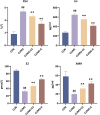Cuscutae Semen in depression-induced ovarian dysfunction: metabolomics with UPLC-QToF-MS in female mice
- PMID: 40370520
- PMCID: PMC12074923
- DOI: 10.3389/fmolb.2025.1595602
Cuscutae Semen in depression-induced ovarian dysfunction: metabolomics with UPLC-QToF-MS in female mice
Abstract
The increasing prevalence of depression profoundly affects female ovarian health. Although Cuscutae Semen (CS) is acknowledged for treating reproductive disorders, its pharmacological mechanisms in depression-induced ovarian dysfunction remain insufficiently explored. This study investigated CS's effects in a chronic unpredictable mild stress (CUMS) mouse model of depression. Mice were divided into control, CUMS model, CS treatment and estradiol treatment group. Behavioral and biochemical analyses assessed depressive-like behaviors and hormone levels. Untargeted metabolomics utilizing ultra-performance liquid chromatography coupled with quadrupole time-of-flight mass spectrometry was applied to identify differential metabolites of CS in the treatment of depression-induced ovarian dysfunction. These findings were confirmed through real-time quantitative polymerase chain reaction assays. Based on the outcomes from behavioral and biochemical assays, CS effectively ameliorated the chronic unpredictable mild stress-induced reproductive ailment in mice. Ten differential metabolites were identified, highlighting the impact of CUMS and CS's ameliorative effects. Pathways linked to arachidonic acid metabolism, glycerophospholipid metabolism, linoleic acid metabolism, and steroid hormone biosynthesis were involved. Seven target genes further validated the metabolomic analysis. This study provides strong evidence of CS's therapeutic potential in alleviating depression-induced ovarian dysfunction, shedding light on its pharmacological mechanisms and supporting its use as a functional medical food.
Keywords: Cuscutae Semen; depression; metabolomics; ovarian dysfunction; ultra-performance liquid chromatography coupled with quadrupole time-of-flight mass spectrometry.
Copyright © 2025 Xie, Zeng, Zhang, Han, Song, Jin and Zhao.
Conflict of interest statement
Author QH was employed by SpecAlly Life Technology Co., Ltd. The remaining authors declare that the research was conducted in the absence of any commercial or financial relationships that could be construed as a potential conflict of interest.
Figures







Similar articles
-
Metabolomics analysis of Semen Cuscutae protection of kidney deficient model rats using ultra high-performance liquid chromatography-quadrupole time-of-flight Mass Spectrometry.J Pharm Biomed Anal. 2022 Jan 5;207:114432. doi: 10.1016/j.jpba.2021.114432. Epub 2021 Oct 20. J Pharm Biomed Anal. 2022. PMID: 34715580
-
Ultra-performance liquid chromatography quadrupole time-of-flight mass spectrometry-based plasma metabolomics study of hepatoprotective effect of cuscutae semen on CCl4 -induced liver injury model of rats.Biomed Chromatogr. 2022 Dec;36(12):e5489. doi: 10.1002/bmc.5489. Epub 2022 Sep 14. Biomed Chromatogr. 2022. PMID: 36002930
-
The effects of a semen cuscutae flavonoids-based antidepressant treatment on microbiome and metabolome in mice.Front Microbiol. 2025 May 15;16:1558833. doi: 10.3389/fmicb.2025.1558833. eCollection 2025. Front Microbiol. 2025. PMID: 40444002 Free PMC article.
-
Metabolomics analysis of the antidepressant prescription Danzhi Xiaoyao Powder in a rat model of Chronic Unpredictable Mild Stress (CUMS).J Ethnopharmacol. 2020 Oct 5;260:112832. doi: 10.1016/j.jep.2020.112832. Epub 2020 May 6. J Ethnopharmacol. 2020. PMID: 32387465
-
Untargeted metabolomics revealed that quercetin improves rat renal metabolic disorders induced by chronic unpredictable mild stress.Naunyn Schmiedebergs Arch Pharmacol. 2025 Apr 25. doi: 10.1007/s00210-025-04186-9. Online ahead of print. Naunyn Schmiedebergs Arch Pharmacol. 2025. PMID: 40274622
References
LinkOut - more resources
Full Text Sources

